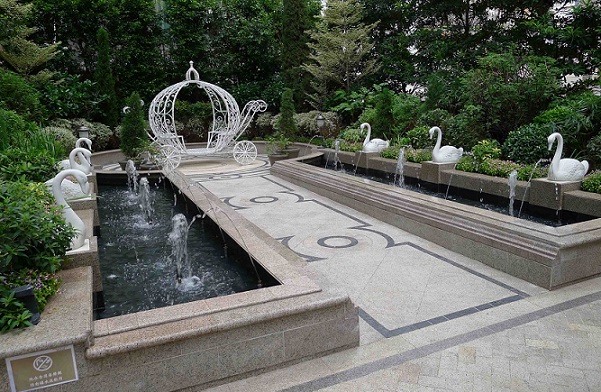藝評
大學門常開,商場拒客來 ∣ Open Universities and Closed Shopping Malls
約翰百德 (John BATTEN)
at 11:54am on 27th September 2016

Caption:
Kitsch 'Wedding/Love' display at The Avenue/Lee Tung Street, Wan Chai
(Please scroll down for English version)
我想在這星期的文章看看兩個地方。我們的大學為共融的暑期活動提供了令人樂見的機會,但是別具歷史意義的利東街,在市區重建局規劃發展後卻顯得一事無成。
幾星期前,我參觀了香港中文大學藝術碩士課程的畢業展覽。那是一個風和日麗的夏日,最適合在花園和大學港鐵站旁的湖畔漫步。這是一個公共空間,開放給所有人使用,不同年紀的兒童都會喜歡。毗鄰的運動場是個舒筋活血的好地方,就算只是坐下來看看書、享受藍天白雲,欣賞日落月出也相當不錯。
大學校園現正為中五和大學同學舉辦夏令課程,但所有都是學術性質(工商管理、語文、工程)。但,有沒有人討論過要開放校園予更多社區人士使用,例如在暑期舉辦社區夏日節?這個空間正好為放暑假的學童舉辦活動,讓他們可以在炎炎夏日有幾小時、整天或全星期體驗戲劇、露營、觀星、遊戲、足球比賽、健體舞、瑜伽、女孩的自信培訓、男孩的烹飪班、園藝、戶外寫生、環境問題研討會和活動、演講與演戲、歌詠、音樂、文化遊、閱讀小組、縫紉與編織、觀鳥,還有在以上每個班之間在周圍的座椅上與友人談天。
我們的大學為學生提供了最佳的設施,但這些設施有否被善用?大學有沒有足夠的社區參與?大學是學習與研究的地方,也應該在全年大部份時間保持這些學術焦點。但是到了夏天,何不把空置的課室和優美的環境開放給其他年輕人作其他用途?這將需要良好的籌備工作、財政預算和人力。但這些都是香港所有的,我們只需要把視野稍稍轉移,由政府利益出發:為這個想法提供公務員口中的「政策支持」,然後向立法會提出撥款申請。
你還記得2007年時,政府拆卸人稱喜帖街的灣仔利東街時,所引起的強烈反響嗎?這是市區重建局(市建局)的重建項目,強制收回了街上的唐樓業權。利東街是一個別具特色的地方:這裡曾經是一個匯聚專門製作與出售喜帖的社群,有印刷商、設計師和商店,很多在這裡工作的人也家在附近。這個身處灣仔繁盛中心的地方,到了晚上會令人意想不到的寧靜。
市民對於整條街道被清拆,所有文化承傳與記憶一掃而空大感痛恨。H15關注組便舉行了多次抗議,希望救回喜帖街。關注組的成員除了社會運動人士,也有很多在利東街居住和工作的街坊。新聞頭條聚焦於店東葉美容的絕食行動。你還記得時任發展局局長林鄭月娥到訪過當地嗎?那時,她呼籲商戶停止絕食,並承諾發展項目完成後會保留喜帖主題。
市建局的利東街發展投標,最終由合和實業有限公司和信和地產贏得。項目現在已建成,包括多幢住宅大樓和以「利東街」為名的商場,商場的英文名字為「Lee Tung Avenue」,為什麼是「Avenue」(大道)而不是「Street」(街)呢?這樣會高貴的點嗎?名字一改,利東街的歷史便被矮化了。當然,不會出人意表的,是項目承諾的喜帖主題已無蹤無影。商場地庫確有幾間喜帖店,但沒有其他喜帖店和相關業務的協同效應,生意前景暗淡。
項目的「公共空間」設在五樓平台,要經沒有清楚標示的升降機才可到達。公眾人士可以前往這個寬敞的空間,但除了可以在這裡坐下和看書,所有其他活動一概禁止。這裡有一個庸俗的「愛」的主題,但我很懷疑可不可以在這裡進行商業的婚照拍攝?項目推出了超過1,000個住宅單位,買家是誰?此外,即使項目就在港鐵旁,卻在早已交通擠塞的區內提供停車場車位。
更侮辱的,是發展商近日向城規會申請使用地面三片狹窄的公共空間作食肆座位用。行人通道本來就已經相當狹窄,戶外用餐的空間也早應在項目設計時便妥善規劃,絕對不應該現在才提出。城規會應該推翻這項申請,因為損失的公共空間對公眾一點好處都沒有!
這個發展項目是令人愁上心頭的:如果你沒有打算購物又或在餐廳用膳,這片地方顯然與你無關,把你拒諸門外。整個項目並沒有多少城市規劃的優點,甚至連一幅展示昔日利東街百業興旺、準新人滿臉喜悅地選擇印刷精美喜帖的照片也找不到。
Translated from English by Aulina Chan
Open Universities and Closed Shopping Malls
John Batten
This week, I consider two places. Our universities offer an optimistic chance for inclusive community summer activities. Whereas, the Urban Renewal Authority’s development of historic Lee Tung Street is a failure of planning.
I visited the Master’s of Fine Arts graduation exhibition at The Chinese University of Hong Kong a few weeks ago. It was a beautiful summer day and perfect for a walk in the gardens and around the lake directly next to University MTR Station. This is public space, open to everyone – and perfect for young and older children. The nearby sports fields are good to exercise on, or, just to sit and read, enjoy the open sky, the clouds, the setting sun and the first glimpse of the moon.
Summer courses are currently run at the university, but all are academic (business administration, languages, engineering) for Secondary 5 and university students. But, has there been any discussion to open up the campus to the wider community – to have a community summer festival running during the school holidays? Organised activities, for school-children during the summer holidays, to enjoy for a few hours, an entire day or a week – to experience: theatre, outdoor camping, sky- and star-gazing, games, football matches, dancing for fitness, yoga, assertiveness training for girls, cooking classes for boys, gardening, outdoor painting, discussions about the environment and then an activity, public-speaking and acting, singing, music, heritage walks, reading groups, sewing and knitting, bird-watching, and in-between these sessions scattered chairs to sit on and chatting with friends.
Our universities have the best facilities for their students, but are they well utilized? Do universities do enough in our communities? Universities are places of academic learning and research and that should be their focus for most of the year. But, in summer, let’s open the empty classrooms and use their beautiful surroundings for other uses and for other young people. It would need good organization and a budget and personnel. But, Hong Kong has that – it just needs a shift in vision, starting with government interest: giving the idea “policy support” as the public servants would say and then a funding request to the Legislative Council.
Do you remember the anger in 2007 about the destruction of Lee Tung Street, better known as Wedding Card Street in Wan Chai? The street was an Urban Renewal Authority (URA) development that compulsorily acquired the tong lau buildings that lined the street. Lee Tung Street was particularly unique: a community of printers, designers and shops devoted to producing and selling wedding cards – with many who worked in the shops also living nearby. At night, it was surprisingly - as it was located in the middle of bustling Wan Chai - completely quiet.
There was outrage at the street’s destruction and the loss of its cultural heritage and memories. Protests to save the street were spearheaded by the H15 Concern Group whose members included activists and many who lived and worked on Lee Tung Street. News headlines focused on the hunger strike of shop owner Yip Mei-yung. Do you remember Carrie Lam Yuet-ngor, the then Secretary for Development, visiting the site? She appealed for the hunger strike to end and promised that the completed development would retain a wedding card theme.
The URA awarded the tender to develop Lee Tung Street to property developers Hopewell Holdings and Sino Land. The development is now complete with apartment towers and a shopping centre branded as “Lee Tung Avenue.” Why ‘Avenue,’ does it sounds more classy? So, just in a simple name change, the history of Lee Tung Street is demeaned. And, no surprise, the development’s promised wedding card theme is nowhere to be seen. There are some wedding card shops in the shopping basement, but prospects are bleak without the synergy of other wedding card and related businesses.
On the fifth floor with access from an unmarked elevator, there is a podium of “public open space.” The public can visit this large area, but apart from reading and sitting all other activities are banned. It has a kitsch ‘love’ theme, but I doubt if even commercial wedding photography would be allowed! There are over 1,000 apartments being marketed for sale – who is buying them? And, despite being located directly next to the MTR, the development has car parking - in an already traffic congested area.
To add insult to injury, the developers recently applied to the Town Planning Board to use three narrow areas of the ground floor public open space for restaurant seating. The walkway passages are already narrow, and provision for outdoor eating should have been properly planned in the development’s design, not now. This planning application should be rejected by the Town Planning Board as there are no benefits to the public for the loss of public space!
This development is a sad sight: if you are not a shopper or eating in a restaurant, the place is ostensibly closed to you. There are few urban planning benefits and there is not even a photograph of the old Lee Tung Street showing its previous commercial buzz and genuine happy couples choosing a beautifully printed red wedding card.
This article was originally published in Ming Pao Weekly on 3 September 2016.
